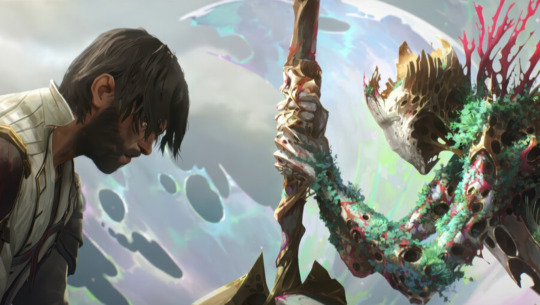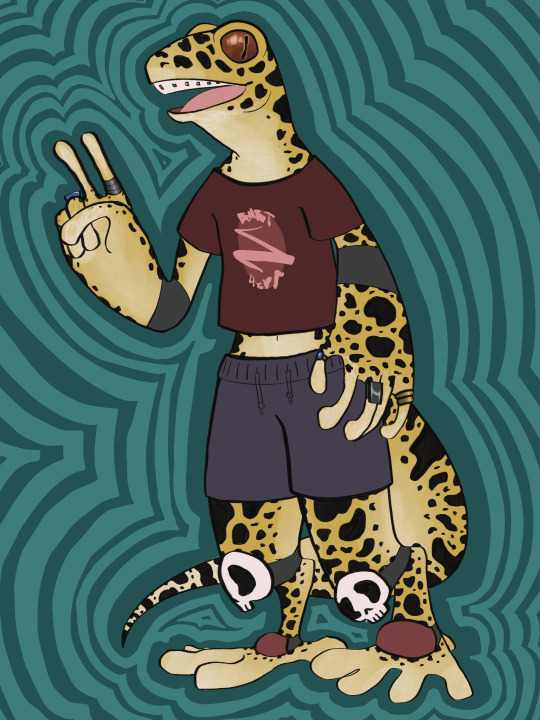#initial mutations
Explore tagged Tumblr posts
Text


Cult of Little Nightmares AU I was cooking a couple weeks ago. 🫢
It’s not fully polished or anything but I felt bad not posting art so I’m sharing early.👍
#Cotl#cult of the lamb#little nightmares#Cotl au#cult of the lamb au#cult of little nightmares#coln#narinder#leshy#heket#kallamar#shamura#the lamb#my art#the bishops are actually all mutated nasty monsters in the au this is just their initial appearance#anyway imma scrounge and see what else i should be sharing since i havent been very active latel
2K notes
·
View notes
Note
What if instead of magic being what turned the seal skin a part of drift it was some stuff that mutaded the leviathans/funky chemicals released in the tsunami that then reacted with mer dna that of the seal skin wich after he wore it a while began to what it did.
Just a wierd idea i got
So let's instead of using magic of love and friendship make the whole turning process be very unnatural and creepy and painful is what I'm hearing?

#huh#apocalyptic ponyo#drift#magic option: oh wow you are turning into something and you didn't even notice at first#toxic chemicals mutation option: oh wow your muscles are falling off of your bones#I need to think#because the whole selkie thing was initially just a joke#and we still have the option of just leaving Drift be a human
542 notes
·
View notes
Text
We know Machine Herald Viktor's ideas of perfection are flawed and influenced by societal values and personal opinion. We've already talked about Viktor's white and gold puppets representing the Piltovian ideal and the shrine Viktor keeps with puppet Jayce and letting Jayce keep his face scar. But, can we talk about the NEWTS?


Like... The only animals we see bigger than an insect that survived the glorious evolution were NEWTS?


You ain't slick wizard man.
#arcane#viktor arcane#jayce talis#crack#arcane meta#jayce arcane#jayvik#mage viktor#I'm sure it actually has something to do with Rio and her mutation being used in the production of shimmer and shimmer being used in the#initial hexcorization of Viktor#wizard Viktor#machine herald#but the potential of Viktor either keeping them that way because he can’t bear directly changing them like Rio#or them just being his favorite makes me smile
777 notes
·
View notes
Text
I don't know how many of the people who play twc have watched Arcane, but I do imagine the scene where Murphy carries out his experiment on the detective to be like the scene where Jinx gets injected with shimmer
#the vampire blood being injected in doses makes sense considering how much murphy fucked up every other time#by initially draining people with the mutation of their blood completely or giving them too much vampire blood#and if the detective was having hallucinations whenever they were awake but kept passing out throughout...#they don't remember that#unless fragments of it all comes back in their nightmares...#👀👀#twc#the wayhaven chronicles#twc detective
12 notes
·
View notes
Note
Question: do you think Charles ever used his groovy mutation line on Erik and if so what physical feature did he pick? Perhaps Erik’s big d[GUNSHOT]
For a moment i forgot the Groovy Mutation line is from First Class and i was gonna point out the literal mutation that is erik’s white hair and say that
Tho ig that line could still work in movieverse…. I think….. just blonde hair.. or w/e fassbender’s hair color is Lowkey I Kinda Never Think About It
#snap chats#like is he a dirty blonde ….. im p sure…. idk why this confounds me so 💀💀#inbox so rarelt mentions movieverse i always have to reread the ask and recontextualize it cause comicverse/tas is always my initial thought#see if charles tries that in comicverse/tas im sure erik wouldve been STRESSINF#like Mutation…… How Absurd……. You Speak Of Utter Nonsense… like girl he just sayin he likes your hair …… shut up…. he tryna hit…..#oh but like to answer the question. highkey i did think of making a silly comic of erik and charles meeting at a bar instead of. The Ocean#and using that line fjsjdwkksk
19 notes
·
View notes
Text
If Singed had a daughter once, is she the reason the mutation must survive? Is the mutation a part of her?
#singed#arcane#league of legends#idk i don't play for the game but why drop that he had a daughter if it didn't mean something?#who or what is the initial mutation?#i don't know the lore i'm sorry lmao
3 notes
·
View notes
Text

elaborating on this before i lose my nerve i just in general think hog is way more turned on by their weird fish person traits than either of them expected and while fish is just kind of confused by all this they just kind of let him do whatever he wants which is how he ends up with eggs in his butt. they didnt even ask him to do that.
#like i think hed be the one to initiate gill stuff and tail stuff and their weird sharp teeth stuff. all of that#fish feels generally very neutral on their body like its fine and theyre content with it but theyre really not their own type#and they kind of expected him to just. humor them i guess and then taper off when things got weird so when hes matching their freak and the#some theyre like ????? ARE YOU LIKE. SURE? WHATS WRONG WITH YOU#and eventually they get used to it but i do think in their mind theyre still like YOU GUYS ARE WEIRD every time one of them#mentions being into one of their mutation traits#🐟#⛓️
6 notes
·
View notes
Text
I think learning irish would cure me
#help girl i'm hyperfixiating on the irish language#been reading for hours about phonology syntax morphology and orthography#also I've started the duolingo course because i finished the korean one and that just isn't enough#I'm gonna look for some better resources#forget about the fact I'd benefit from learning korean since I'll be needing it to actually communicate with people soon#girl help your vso word order inflected propositions and initial consonant mutations have bewitched me
8 notes
·
View notes
Text
couldn't find any documentation on how many cells you get from boss rush, so i worked it out myself! (to the best of my abilities anyway lol, also if this info is out there already then i must have missed it in my search 😅 sorry)
quick note: this might not be 100% accurate, since i mostly used math instead of fighting every boss 6 times lol. but i definitely gathered enough data to find a consistent pattern, so if these numbers are off at all, they should at least be VERY close, and at least 0bc and 5bc are definitely correct.
so, here's the numbers for each difficulty!
Concierge: 24 / 25 / 26 / 27 / 28 / 30
Conjunctivius: 40 / 42 / 44 / 46 / 48 / 50
Mama Tick: 32 / 33 / 35 / 36 / 38 / 40
Death: 80 / 84 / 88 / 92 / 96 / 100
Time Keeper: 40 / 42 / 44 / 46 / 48 / 50
Giant: 60 / 63 / 66 / 69 / 72 / 75
Scarecrow: 50 / 52 / 55 / 57 / 60 / 62
Dracula: 80 / 84 / 88 / 92 / 96 / 100
Hand of the King: 80 / 84 / 88 / 92 / 96 / 100
Servants: 47 / 49 / 51 / 54 / 56 / 60
Queen: 80 / 84 / 88 / 92 / 96 / 100
Dracula Final Form: 40 on all difficulties
ALSO: you don't get any more cells than normal from modified bosses or flawless wins. the 4 trials give the same amount as DIY mode, so there's no bonus there as far as cells go.
#dead cells#oh yea also i haven't looked into it but you can get a couple extra cells sometimes??? idk why or how#while farming the giant i got 1 or 2 extras sometimes. not sure if it's a bug or related to the seed or what but. yea. idk#anyways yea hotk and queen are the best for cell farming i think#the strat i used was: all legendary custom mode with nothing but cursed sword and barricade#all mutations locked except for combo/tainted flask/demonic strength (or initiative if not on the beta)#set enemy health to 20% in assist mode. go in the boss room. take a sip. melt the boss in under 10 seconds. easy cells#hotk dies before he can finish winding up his opening attack#queen is slightly faster to farm due to the lack of cinematics but her attack patterns are random so you cant just turn your brain off#btw if you do this method: just remember to switch barricade to catalyst BEFORE picking up a sword lmao. i messed that up many times#alsooo idk how seeds work regarding versions and platform and such but. for the steam beta with all dlc at least:#514114 gives a sword with bonus to poison+bleed on 5bc#it's the second sword in the pedestal room. if you use this seed probably take open wounds instead of combo/initiative#a 300% damage bonus would probably be best though lol but i couldn't find one sadly#if you wanna farm without custom/assist mode then godspeed and good luck 🫡
5 notes
·
View notes
Note
Honestly, I got invested only because I got obsessed with idea of writing fanfic with premise:
"A girl doomed by narrative fucking claws and bites her way against literal God of the forest, to get her happy ending (In the process fucking up everyone around her even more than they already were)" :p
I dig that for a premise tbh.
I wish this show was more like that.
Just a bunch of girls in the forest slowly losing their humanity as they try to survive circumstances beyond their control.
I like that kind of idea. (But I would be adding shit like forest creatures and a happy ending that isn't really happy)
#i love when people toil with their humanity that's why i love mia so much#she gives the vibes of someone who has had their perception of themself change dramatically and still questions their own humanity despite#living a domestic life again. just because of the shit she did#i love that shit#i think alcina initially struggled with that after being mutated but has made peace with what she is. But she's had a century and mia's had#like 3 years or so#asks#horror lady00
6 notes
·
View notes
Text

Mondo Gecko! Wow what a cool dude
-
here’s Slash and Leatherhead as well :)
#my art#tmnt au#tmnt iteration#tmnt paranoia#tmnt mondo gecko#he was also mutated in the initial event but he was baby at the time#so he’s lived as a mutant his whole life#lives with his mom who is also mutated and is next door neighbors with slash
5 notes
·
View notes
Text
He wanted to turn ALL the big anti mutant supporters into mutants!

#i thought the goo was senator kelly's initial mutation#it was like a metaphor bc he was slimey and spineless#the plan failing was him spontaneously turning to water??#i watch this series once a month#x1 and x2#they lost me when they killed scott
165K notes
·
View notes
Text
youtube
#Carcinogenesis#tumor initiation#cancer progression#oncogenesis#genetic mutations#epigenetic alterations#oncogenic pathways#tumor suppressor genes#DNA damage repair#cell proliferation#metastatic cascade#angiogenesis#inflammation and cancer#tumor microenvironment#oxidative stress#apoptosis resistance#cellular transformation#mutagenesis#carcinogenic agents#chemoprevention.#Youtube
0 notes
Text
wrt covid if i had to choose i would much rather people wear n95/kn95 masks than get vaxxed considering we STILL don't have a sterilizing vaccine that prevents transmission and infection- masking and cleaning the air are currently the only preventative measures :/ (and while they may not be 100% effective the less viral load you intake and the less infections you get overall, the better)
#covid#vaccines help u survive the initial infection but bc covid is mutating so rapidly its becoming less effective at even that#they dont prevent long covid or the damage from covid#so the goal is to avoid getting it as much as possible at least until we have proper treatments and vaccines#also cant stand the 'but masks dont work' ppl who wear cloth/surgical and constantly have it below the nose or take it off to eat indoors
1 note
·
View note
Text
Seraikela Land Office Clerk Arrested in Bribery Sting
Anti-Corruption Bureau Nabs Official Accepting ₹8000 for File Processing A head clerk at Land Reforms Sub-Collector’s Ofice caught red-handed in ACB operation following complaint from local landowner. SERAIKELA – The Anti-Corruption Bureau (ACB) has arrested S Nanda, a head clerk at the Land Reforms Sub-Collector Office in Seraikela, for allegedly accepting a bribe of ₹8000. The arrest occurred…

View On WordPress
#Anti-Corruption Bureau Jamshedpur#राज्य#bureaucratic transparency initiatives#Jamshedpur anti-corruption efforts#Jharkhand ACB operations#land mutation corruption#land office bribery#Prevention of Corruption Act#S Nanda arrest#Seraikela corruption case#Singh Soy complaint#state
0 notes
Text

Horses are among the world’s most elite athletes: When galloping, they can consume twice as much oxygen per kilogram as the fittest humans. All that oxygen supercharges horses’ cells’ energy-producing compartments as they crank out ATP, the chemical needed to power their impressive muscles. But making so much cellular fuel so quickly comes with a catch: the manufacture of pernicious byproduct molecules called reactive oxygen species (ROS), which can wreak havoc in cells.
How horses dealt with this biological trade-off and evolved into premier endurance athletes has long intrigued biologists. Researchers report today in Science that they have uncovered a big part of it, identifying a key mutation that lets horses safely produce so much ATP. The trait helped pave the way for horses to go from dog-size critters millions of years ago to the high-endurance athletes we know today.
The study’s detailed molecular work makes it “exceptional,” says José Calbet, an expert on the cellular responses to exercise at the University of Las Palmas de Gran Canaria who wasn’t involved with the study.
The mutation in question occurs in the gene that encodes a protein called KEAP1, which acts as a biochemical bouncer, binding to a different protein called NRF2 to prevent it from entering the cell’s nucleus, where it would otherwise activate stress-response genes that help blunt cell damage.
But ROS can help NRF2 sneak in by causing KEAP1 to release its bind on the protein, allowing it to enter the nucleus and trigger the cell’s stress-response genes.
Johns Hopkins University ophthalmologist and clinician scientist Elia Duh, a senior author of the new study, didn’t set out to study horses. Initially, Duh was interested in the KEAP1-NRF2 system because its role in activating stress-response genes makes it a tempting target for treating inflammation—and aging-related conditions, such as blinding retinal diseases, irritable bowel syndrome, and neurodegeneration.
Duh wondered whether any insights could be gleaned from studying the evolution of these proteins in different animals. So, he teamed up with Gianni Castiglione, an evolutionary biologist and biochemist at Vanderbilt University. Together, they scanned hundreds of vertebrate genomes looking for notable mutations to the gene for KEAP1.
The team’s genomic work revealed birds had almost completely lost the gene, presumably an adaptation to the extreme demands of flight. When they looked in horses, researchers noticed what initially appeared to be a DNA sequence that encoded an unusually short—and therefore presumably nonfunctional—version of the KEAP1 protein. But when Duh’s and Castiglione’s team grew horse cells in culture, it discovered the protein was very much there and working. “Naturally, I was worried I was doing something wrong,” Castiglione says. “Then one day, a light bulb went off.”
As it turns out, the computer algorithm scientists had used to scan the horse genome had made a mistake. The algorithm had spotted a specific kind of mutation in the part of the KEAP1 gene that changed the messenger RNA from CGA—which codes for the amino acid arginine—to UGA, which is what’s known as a “stop codon.”
Normally, the cellular machinery interprets UGA as a sign to stop translating the RNA into a protein. But instead, the horses’ genetic machinery recodes the stop codon into a different amino acid, cysteine, causing it to ignore that order. This phenomenon, known as a stop codon read-through, is common among viruses but rare in multicellular organisms.
“The identification of this evolutionarily significant UGA recoding event represents a potentially seminal finding, offering a model for uncovering other yet-unidentified cases of stop codon read-through,” says Hozumi Motohashi, a biologist at Tohoku University who has studied KEAP1 and NRF2.
That the replacement is a cysteine is particularly notable, Castiglione says. KEAP1 senses cellular stress through its cysteines, which contain sulfur atoms whose reactions with ROS, induce the chemical changes that cause KEAP1 to let go of NRF2. The mutation the researchers had identified adds another place on KEAP1 for ROS to interact, which makes the protein more sensitive to stress—and lets horse cells respond much faster to the cellular stress of intense exercise. “It does make complete sense [that] by introducing another cysteine, another sulfur, you would have heightened sensitivity,” Castiglione says.
What’s more, this tweaking of KEAP1 is a “[key] genetic component to the puzzle of the evolution of horses,” Duh says. “Once they figured out how to run, they could occupy all kinds of ecological niches,” Castiglione adds.
The finding could also point the way toward new kinds of drugs to treat diseases by targeting the specific parts of the KEAP1 protein that help horses hoof it. “By looking at what evolution has figured out, we know this is a viable strategy,” Castiglione says.
Source
811 notes
·
View notes